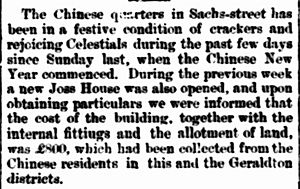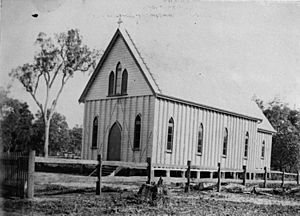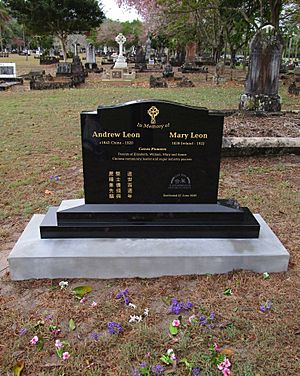Andrew Leon facts for kids
Andrew Leon (born around 1841, died 1920) was an important Chinese-Australian businessman. He lived mostly in northern Queensland, especially around Cairns. He started the Hap Wah plantation, which was a pioneer in growing sugarcane in the Cairns area. From the 1870s to the 1890s, he was seen as the main leader of the Chinese community in Cairns.
Contents
Andrew Leon's Early Life and Travels
Andrew Leon was born in Zhongshan, China. His father was a Cantonese merchant. When he was young, Andrew learned a lot about farming sugar in Cuba, where sugar production was a huge industry. In 1866, he moved to Queensland, Australia.
His first known stop was in Bowen. In 1868, he was baptised at St Mary's Roman Catholic Church. The next year, in February 1869, he married Mary Piggott, who was from Ireland, in the same church. In September 1869, he became a naturalised British subject. This was important because it allowed him to own land in Queensland. By this time, he had been in Queensland for about three and a half years.
Over the next six years, Andrew Leon and his family moved often. They followed the gold discoveries across North Queensland. His four children were born in different towns: Elizabeth in Bowen, William in Townsville, Mary in Millchester, and Annie in Cooktown. He worked on the Ravenswood goldfields in 1870 and 1871. In 1874, he was in Millchester, where he helped as an interpreter in court. By 1875, he moved his family to Cooktown. This town was a new port for the Palmer goldfields. In Cooktown, he signed a petition for the town to become a municipality. He also worked for Sun Tung Lee and Co. and managed the Sun Yee Lee and Co. stores.
Starting Businesses in Cairns
Andrew Leon arrived in Cairns early, in 1876. He opened one of the first Chinese businesses there, called Sun Chong Lee, on Abbott Street. He partnered with Chuck Lum, a businessman from Cooktown, and bought the land for the business.
Hap Wah Plantation: A Sugar Pioneer
Two years later, in 1878, Andrew Leon started the Hap Wah plantation. This plantation was very important because it was the first to grow sugarcane on a large scale in the Cairns area. A group of Chinese traders from Hong Kong joined with local businessmen to form the Hap Wah Company. They invested a lot of money, £45,000, to start this big farming project. This was the first large sugar farm in Far North Queensland. Andrew Leon was the manager and the main spokesperson for the whole project.
The "Pioneer" sugar mill on the Hap Wah plantation was the first sugar mill in the Cairns district. Its grand opening in 1882 was a big event. Many important people and guests attended. The mill started testing sugar production in early April and began full production in June. By the end of December that year, Hap Wah had already exported 110 tons of sugar. This sugar was worth £3,060.
The Hap Wah plantation and mill were located along Mulgrave Road. The plantation included two main areas of land. These areas are now part of the suburbs of Earlville, Woree, and Bayview Heights.
The plantation was at its busiest in 1884, with 200 Chinese workers. However, around this time, world sugar prices dropped by a third. This made it very hard for sugar businesses. Even though Hap Wah produced sugar well, it had to close in 1886. Other sugar plantations in the area also struggled. When Hap Wah closed, its land was sold to Thomas Mills, a businessman. The sugar mill itself was sold to Noakes Bros and moved to Bundaberg in December 1887. Even though Hap Wah was open for only a short time, its investment and production were very important. It helped start the sugar industry in Far North Queensland.
Other Business Ventures
Andrew Leon was a very creative farmer and businessman. After selling the Hap Wah plantation, he started new projects. He created orchards and sold timber from his Maryvale Estate. This was a large property of 1280 acres located above the Barron River Valley.
The growing farming industry in Cairns attracted many Chinese people. They also worked in related businesses, like market gardening and running shops. By 1886, Chinese migrants made up nearly a third of the non-Indigenous population in the Cairns district. In the town itself, one out of every five residents was Chinese.
Sachs Street, near the town center, became the main area for Chinese businesses and community life. It had shops, merchant houses, two temples, and boarding houses. Andrew Leon and James Ah Ching were among the Chinese investors who helped develop this area. Leon's early land purchases provided places for Sam Sing and Co., Sun Wo Tiy, and Lee Yan Bros. These were the three largest and longest-lasting Chinese merchant firms from the 1880s to the 1920s.
Leon also owned other properties. These included his family home at 67 McLeod Street. He also owned properties along the planned route of the Cairns-to-Herberton railway line. His land extended as far as Aramac. He bought his last properties during the 1893 economic downturn.
In late 1886, Leon bought his third piece of land in Sachs Street (now Grafton Street). The first building built there was the Lit Sung Goong temple. It opened during Chinese New Year in 1887. A few years later, four shops were built. Today, only one of these shops remains and is listed on the Queensland Heritage Register as 99 Grafton Street.
In 1890, Andrew Leon set up a special trust. This trust made sure that the temple property would stay with the Cairns Chinese community. Leon and Jan Bung Chong were named as trustees. This trust protected the community's ownership. In 1966, due to financial difficulties, the temple land had to be sold. However, the trust kept the items from inside the temple. Because of this, the important Lit Sung Goong collection of temple artifacts is still with the Chinese community. It is cared for by the Cairns & District Chinese Association Inc (CADCAI). Leon made similar trust arrangements to help other Chinese people own property. He used his status as a naturalised British subject to do land deals that many other Chinese residents could not do.
Andrew Leon: Interpreter and Community Leader
When Chinese people were involved in court cases, interpreters were needed. Andrew Leon worked as an interpreter from at least 1874 to 1905. He helped in various courts, including Petty Sessions, Police Courts, and the Northern Supreme Court in Townsville for serious cases. His interpreting skills were also very important for the Chinese community in general. For example, in the late 1890s, the Cairns banana industry had a problem with fruit flies. Chinese growers and shippers ran most of this industry. Leon interpreted the many issues and concerns at a large meeting held at the Lit Sung Goong temple.
Chinese migrants were a key part of the early Cairns economy. They played a big role in its growth. Andrew Leon was an essential link between the Chinese community and the wider community. He had experience in business, farming, and property investment. He also spoke English fluently and adopted Western clothing and manners. These qualities earned him a respected position of leadership among both the Chinese and the wider communities.
When government officials visited Cairns, they were greeted by town leaders and important citizens. Chinese delegations were always there too. In 1881, Andrew Leon was likely the Chinese representative who welcomed the Queensland Governor Sir Arthur Kennedy. He presented the Chinese address of welcome and showed their loyalty. During Queensland Governor Sir Henry Wylie Norman’s visit in 1890, Leon again presented the Chinese address. It thanked the Governor for his "uniform kindness" to the Chinese in Queensland. It also mentioned that the Governor's short visit would prevent him from seeing the "agricultural and other industries of our countrymen." However, it expressed hope that he would value their "tribute, though small, to the advancement of the district we have adopted as our home…".
Andrew Leon's Later Life
As the owner of Maryvale Estate, Andrew Leon was involved in local government matters. He also managed his property into the 1900s. In court, he was known for being reliable. This led to him being chosen as an interpreter for serious crimes like murder. He remained a trustee of the Lit Sung Goong temple until he passed away. Between 1900 and 1906, his two daughters who lived to adulthood married Irish-Catholic men in Cairns. Each family had three children. One of Andrew Leon's four grandsons, Jack Cleary, became a well-known and respected musician in Innisfail and Cairns.
In 1901, the Australian colonies joined together to form the Commonwealth of Australia. The new government quickly introduced the White Australia policy. This policy was put into law through the Immigration Restriction Act No. 17 of 1901. It was designed to stop all non-Europeans from moving to or returning to Australia. This law had a very harsh impact on Chinese people and others who were considered "aliens." It was especially difficult for the Leon family.
William Andrew Leon, Andrew's only son, had been sent to China for his education in 1878. He planned to return in 1899, but illness delayed him until 1903. By then, the Immigration Restriction Act was strictly enforced. Even though William was born in Townsville and was a British subject, he was considered an "alien." This meant that to re-enter Australia, he would have to pass a dictation test. He would need to write a 50-word passage dictated in any European language chosen by an immigration officer.
Knowing this, Andrew Leon asked for advice from Robert Taylor Hartley, a customs officer in Townsville. Hartley wrote to the customs office in Brisbane. He included William's Queensland birth certificate and his own note from 1899 saying William should be allowed to return. He also stated that he had known Andrew Leon for 25 years and was sure Leon would not try to bring anyone else into the country. A week later, Atlee Hunt, Secretary of the Department of External Affairs, replied. He said that William's re-entry was only possible if he passed the dictation test. There is no record that William ever returned to his family in Cairns.
Even though many Chinese immigrants went back to China to retire, Andrew Leon stayed in Cairns. He passed away on June 27, 1920, at his home in McLeod Street, Cairns. He was 80 years old and died from cancer. His funeral was held at St Monica's Roman Catholic Church (which is now St Monica's Old Cathedral) in Cairns. Afterward, his funeral procession went to the Martyn Street cemetery, where he was buried.
Andrew Leon's Legacy
A special plaque was put up on January 24, 2013, to remember the Hap Wah enterprise. It is located at the Stockland Cairns shopping center in Earlville, which was built on part of the old Hap Wah plantation. The plaque honors the important work of the Hap Wah project, its manager Andrew Leon, and the "Chinese inspiration, businesses and agricultural enterprise that were crucial to the development and economic viability of early Cairns."
On June 27, 2020, which was 100 years after Leon's death, a memorial headstone was placed. It marks the gravesite of both Andrew Leon and his wife Mary, who died on June 21, 1922. Before this, their graves were unmarked.
The Cairns Regional Council named Leon Close in Brinsmead after Andrew Leon.
The Cairns Historical Society has two collections about Andrew Leon:
- The Hap Wah & Andrew Leon Collection, which contains new research and materials.
- The Leon-Cleary Collection, Father Michael Bonner Estate, 2017. This collection includes over 200 family photos from around the 1920s and other items.
Both collections can be seen by the public at the Cairns Historical Society Research Centre, which is inside the Cairns Museum. Even after a lot of research, Andrew Leon's Chinese name is still not confirmed. Also, despite his well-known leadership, no photos of him or his wife have been found.
Images for kids













